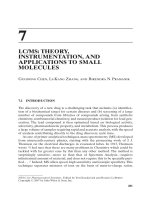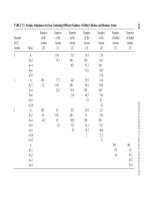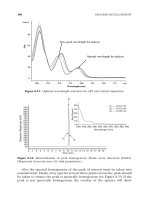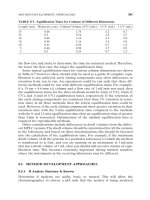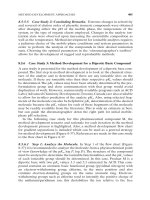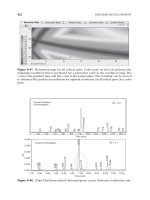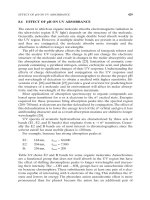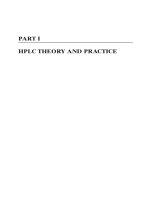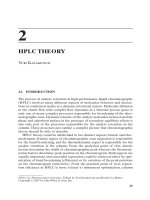Tài liệu HPLC for Pharmaceutical Scientists 2007 (Part 7A) pptx
Bạn đang xem bản rút gọn của tài liệu. Xem và tải ngay bản đầy đủ của tài liệu tại đây (546.45 KB, 29 trang )
7
LC/MS: THEORY,
INSTRUMENTATION, AND
APPLICATIONS TO SMALL
MOLECULES
Guodong Chen, Li-Kang Zhang, and Birendra N. Pramanik
7.1 INTRODUCTION
The discovery of a new drug is a challenging task that includes (a) identifica-
tion of a biochemical target for certain diseases and (b) screening of a large
number of compounds from libraries of compounds arising from synthetic
chemistry, combinatorial chemistry, and natural product isolation for lead gen-
eration. The lead compound is then optimized based on biological activity,
selectivity, pharmacokinetic property, and metabolism. This process produces
a large volume of samples requiring rapid and accurate analysis, with the speed
of analysis contributing directly to the drug discovery cycle time.
As one of primer analytical techniques, mass spectrometry (MS) developed
from nineteenth-century physics, starting with the pioneering work of J. J.
Thomson on the electrical discharges in evacuated tubes. In 1913, Thomson
wrote “I feel sure that there are many problems in Chemistry which could be
tackled with far greater ease by this than any other method. The method is
surprisingly sensitive—more so than that of Spectrum Analysis—requires
infinitesimal amount of material, and does not require this to be specially puri-
fied. . . .” Indeed, MS offers speed, high sensitivity and isotopic specificity. This
technique separates mixtures of ions on the basis of mass-to-charge ratios,
281
HPLC for Pharmaceutical Scientists, Edited by Yuri Kazakevich and Rosario LoBrutto
Copyright © 2007 by John Wiley & Sons, Inc.
providing the molecular weight of a compound and its structural information
from fragment ions. It is widely used for identification and quantification of
known/unknown organic compounds. Rapid development of MS in recent
decades has further expanded its role in the structural characterization of
small molecules in the drug discovery process [1].
In combination with chromatographic separation techniques, principally in
the form of high-performance liquid chromatography (HPLC) / MS (LC/MS),
mass spectrometry has become the principal method of mixture analysis in
pharmaceutical research and development [2]. Early discovery research often
involves library compounds analysis using high-throughput LC/MS methods.
Identification and quantification of drug metabolites is essential in drug
metabolism and pharmacokinetic studies. Structural characterization of impu-
rities and decomposition products in bulk drug substances is an integral part
of pharmaceutical product development. LC/MS combines the high-resolution
separation capability of HPLC with MS detection and characterization ability,
playing important roles in all these aspects of drug discovery process.
7.2 IONIZATION METHODS AND LC/MS INTERFACES
Different physical principles can be used to separate and measure ions
(charged particles) with different mass-to-charge ratios under high vacuum
conditions, and this has resulted in a variety of mass spectrometers [3]. In prin-
ciple, the functioning of all mass spectrometers in generating mass spectra
involves four steps: (1) introduction of the sample; (2) ionization of the sample
molecule to convert the neutral molecules to ions in the gas phase (ionization
method); (3) sorting of the resulting gas-phase ions by mass-to-charge ratios
(mass analyzer); and (4) detection of separated ions. Critical components of a
mass spectrometer include ion source and mass analyzer. Depending on
desired applications and sample types, different mass spectrometers can be uti-
lized to perform specific analytical tasks.
7.2.1 Ionization Methods
An ideal ionization source for a mass spectrometer should provide a high ion-
ization efficiency and a high stability of ions for subsequent mass analysis by
mass analyzers. In addition, control of internal energy deposited on ions during
ionization should be achievable in the ionization source to control the degree
of fragmentation. It is also desirable to couple ionization source with chro-
matographic separation techniques, especially with HPLC. Various ionization
methods have been developed over the years, including electron impact (EI),
chemical ionization (CI), desorption ionization (DI), matrix-assisted laser des-
orption/ionization (MALDI), desorption electrospray ionization (DESI), elec-
trospray ionization (ESI), and atmospheric pressure chemical ionization
(APCI). Note that ESI and APCI are part of LC/MS interfaces that will be
282 APPLICATIONS TO SMALL MOLECULES
discussed in separate sections. Table 7-1 summarizes some characteristics of
different ionization methods.
EI and CI are two early developed ionization methods. They are extremely
useful for ionizing volatile compounds. In EI process, molecules are ionized
by collisions with energetic electrons (typically 70 eV) produced from a heated
filament. It produces highly reproducibly mass spectra with extensive frag-
mentation of molecular ions. Thus, library searching with existing EI mass
spectra is possible for unknown identifications. The nature of fragmentation
in EI often leads to lower abundances or absence of molecular ions. On the
other hand, CI is a soft ionization method that generates mainly molecular
ions by ion/molecule reactions of regent ions with analyte molecules [4].
IONIZATION METHODS AND LC/MS INTERFACES 283
TABLE 7-1. Summary of Ionization Methods
Ionization
Method Ionization Agent Strengths Limitations
EI Electrons (∼70 eV) Extensive Limited to
fragmentation, volatile/
reproducible nonpolar
spectra, searchable molecules
large reference
compound EI
libraries
CI Gaseous ions Abundant molecular Limited to
ions with nonpolar and
controllable moderately
fragmentation polar
molecules,
limited
fragmentation
APCI Corona discharge/ Operative at Limited to low
gaseous ions atmospheric to moderately
pressure, easy polar
interface to molecules
HPLC, abundant
molecular ions
DI Energetic particles Abundant molecular Difficult to
(atoms, ions), ions from high- interface to
photons mass compounds HPLC
ESI Electrical/thermal/ Operative at Poor results for
pneumatic atmospheric nonpolar
energy pressure, easy molecules,
interface to HPLC, limited
multiple-charged fragmentation
ions for large
biomolecules
Commonly used reagent gases include methane, ammonia, and isobutane. The
internal energy deposition or fragmentation of ions determines the appear-
ance of mass spectra. It can be controlled by selecting appropriate reagent
gases. In terms of proton transfer reactions in CI-MS, the relative proton affin-
ity between the analyte and the reagent gas determines whether the analyte
will be ionized. The analyte with a higher proton affinity than that of the
reagent gas will be ionized, while the analyte with a lower proton affinity than
that of the reagent gas will not be ionized. Furthermore, the difference in
proton affinities of reagent gas and analyte is largely responsible for the extent
of fragmentation if ionization of the analyte occurs.
EI and CI methods are complementary to each other, providing molecular
weight and structural information. As an illustration, Figure 7-1 shows an EI-
MS spectrum of mometasone furoate, an anti-inflammatory steroid drug. A
very low abundant molecular ion at m/z 520 is visible. However, the base peak
in the spectrum is the fragment ion at m/z 295 corresponding to the loss of
furoate ring, HCl, and a moiety of [COCH
2
Cl]. Other fragment ions in the
spectrum yield structurally characteristic fragmentations for this molecule. In
contrast, a CI-MS spectrum of the same compound exhibits the protonated
molecular ion as the most abundant peak at m/z 521 along with some frag-
ment ions (Figure 7-2). The appearance of these two spectra clearly demon-
strates the utility of EI-MS and CI-MS methods.
An inherent limitation for EI and CI methods is the requirement that the
sample analyzed must be volatile. Both methods do not produce MS data for
284 APPLICATIONS TO SMALL MOLECULES
Figure 7-1. EI-MS spectrum of mometasone furoate
.
polar compounds. One solution to this limitation is to employ DI methods to
ionize nonvolatile samples with high molecular weights [5]. In the DI process,
energetic particles or photons impact onto samples on a surface and result in
the liberation of intact molecular ions via selvedge region without direct trans-
fer of the energy to the sample molecules. The particle bombardment includes
keV atoms (e.g., Ar, fast atom bombardment [6]), keV ions (e.g., Cs
+
, liquid
secondary ion MS [7]), and MeV ions (e.g., plasma desorption [8]). Both fast
atom bombardment (FAB) and liquid secondary ion MS (LSI) utilize large
excess matrix for absorption, excitation, and relaxation of energetic particles,
producing mainly molecular ions of interest. They are well-suited for studies
of natural products and small polar compounds with molecular weights of a
few thousand daltons (Da). Another important DI method is MALDI, which
employs a UV or IR absorbing matrix in large excess with samples (5000 :1)
to absorb the photon energy from laser irradiation [9]. This method generates
mostly singly charged molecular ions with molecular weight as high as
500 kDa. MALDI has a high ionization efficiency for large biomolecules with
supersensitivity in the range of low-femtomole level. It has become one of
most widely used ionization methods in biological mass spectrometry.
The latest addition to DI methods is DESI [10]. It directs an aqueous spray
from an electrospray apparatus onto the sample on a surface. In the process,
the fast nebulizing gas jet transports the charged droplets and impacts the
IONIZATION METHODS AND LC/MS INTERFACES 285
Figure 7-2. CI-MS spectrum of mometasone furoate using NH
3
as CI reagent gas.
surface in the absence of matrix, carrying away analyte molecules. This
approach has been successfully applied to analysis of small molecules and
proteins. The unique characteristic of DESI is that it operates under
ambient conditions.All other DI methods as described above normally require
vacuum operation conditions, and sample manipulation during experiments is
not feasible. DESI lifts the restriction on the vacuum constraints and can be
very flexible in carrying out novel experiments. Potential applications include
forensic analysis, explosive detection, and biological imaging experiments in
tissues.
7.2.2 Historical View of Interfaces
A critical component of the LC/MS system is the interface that connects an
HPLC system to a mass spectrometer. The basic requirements for a success-
ful interface include maintaining chromatographic performance (minimum
additional peak broadening), high transfer efficiency from LC to MS, and no
degradation in mass spectrometric performance. Historically, a main challenge
in LC/MS interfaces was that high liquid flows from HPLC make it very dif-
ficult to maintain the high vacuum required for the function of a mass spec-
trometer. A number of different LC/MS interfaces have been developed over
the years to address this issue and overcome the difficulty [3].
7.2.2.1 Direct Liquid Introduction. One of the first attempted experiments
to introduce liquids into a mass spectrometer was to minimize the amount of
liquid into an MS, removing solvent by the vacuum system and ionizing the
analyte in the gas phase. The pioneering work carried out by Tal’roze et al.
[11] described the simplest direct liquid introduction interface. In their
experiments, solvent was introduced into the mass spectrometer through a
capillary at a flow rate below 1 µL/min. The ionization of analytes occurred by
EI. The low flow rate used in the experiments was a limitation and would not
give good sensitivities for analytes. In 1970s, McLafferty’s group employed
a direct liquid introduction (DLI) interface to directly introduce a small
fraction (<1%) of the liquid from HPLC into the ion chamber of a CI mass
spectrometer [12]. The solvent acted as the ionizing reagent. The maintenance
of the vacuum was assisted by using large pump systems and differential
pumping. Micro-and nanobore chromatography (<1-mm-i.d. column) were
suitable for DLI. A detection sensitivity of picogram level was achieved for
full-scan analysis.
7.2.2.2 Moving Belt System. Initially developed by McFadden et al. [13],
the moving belt system was based on the physical method of evaporation of
the mobile phase through heat and vacuum that leave analytes as a thin
coating on a continuously cycling polyimide belt. The analytes were trans-
ported from atmospheric pressure region to the vacuum of the ion source
through differentially pumped vacuum locks. Ionization methods used
286 APPLICATIONS TO SMALL MOLECULES
included EI and CI for volatile analytes. The system has excellent enrichments
and efficiencies, although it is often limited to the analysis of compounds which
could have been analyzed by gas chromatography (GC)/MS.
7.2.2.3 Thermospray. The thermospray interface was introduced and devel-
oped by Blakley and Vestal [14]. In their approach, a liquid flow from HPLC
was directed through a resistively heated capillary connecting to the MS ion
source. The heat and vacuum would evaporate the solvent from a supersonic
beam of mobile phase produced in the spray, creating charged small micro-
droplets. These small liquid droplets were further vaporized in the heated ion
source. Ions present in the ion source were then transferred to the mass
analyzer, and residual vapors were pumped away.
Ionization process in thermospray involves ion desolvation/evaporation
from charged liquid droplets and gas-phase ion/molecule reactions. Both pos-
itively and negatively charged ions are formed in the process. Volatile buffers
such as ammonium acetate are often used as part of HPLC effluent. These
buffer ions act as CI reagent ions to form either protonated or deprotonated
ions. The gas-phase proton affinity (for positive ion) or acidity (for negative
ion) of the analyte relative to the buffers will determine whether the analyte
will be ionized. If the proton affinity of the analyte is lower than that of the
reagent ion, the analyte will not be ionized. This CI-like aspect of the ioniza-
tion process results in thermospray mass spectra containing mostly molecular
ions. When buffer is not used in thermospray experiments, an external ioniza-
tion method is often applied, including EI filament and discharge ionization.
These supplemental modes produce solvent-related CI mass spectra.
A main advantage of thermospray is that it can handle commonly used
HPLC eluents at higher flow rates (up to 2 mL/min) and generate good results
for polar, nonvolatile, and thermolabile compounds. However, the sensitivity
of the method is highly compound-dependent and not particularly attractive
to high-molecular-weight compounds.
7.2.2.4 Continuous-Flow FAB. Continuous-flow FAB is a modified form
of FAB method [15, 16]. In this modified method, the HPLC effluent with
added FAB matrix (usually 5% aqueous glycerol) is continuously transported
through a fused-silica capillary to the tip of a FAB probe residing inside of the
ion source. The HPLC liquid with matrix deposited on the tip of the FAB
probe is subjected to atom bombardment for ionization of analytes.The matrix
addition can be done either pre-column or post-column, although post-column
addition is preferred. The acceptable liquid flow rate in continuous-flow FAB
is less than 10 µL/min. Flow splitting or the use of capillary chromatography
is often required in the experiments. A major advantage in this method is the
reduced chemical noise since much less matrix is used in continuous-flow FAB
than in standard FAB experiments. This has led to improved detection limits
to subpicomole range. Significantly, this interface allows the LC/MS analysis
of biomolecules that are traditionally analyzed by DI methods.
IONIZATION METHODS AND LC/MS INTERFACES 287
7.2.3 Common Interfaces
The early developed LC/MS interfaces as described above have played impor-
tant roles in the evolution of LC/MS interfaces. However, their applicability,
sensitivity, and robustness are very limited. The overwhelming popularity of
LC/MS today is largely due to the development of atmospheric pressure ion-
ization (API) interfaces, including ESI and APCI.
7.2.3.1 Electrospray. The first description of ESI was made by Zeleny in
1917 [17]. He described how a high electrical potential applied to a capillary
caused the solvent to break into small droplets. In late 1960s and early 1970s,
Dole and co-workers attempted to generate gas phase ions from macromole-
cules in solution using an atmospheric pressure electrostatic sprayer by ion
mobility spectrometry [18, 19]. In the late 1970s, Thomson and Iribarne suc-
cessfully demonstrated the production of macro-ions from electrically charged
droplets using MS [20, 21]. The very first applications of ESI were reported
independently by Yamashita and Fenn [22] and Aleksandrov et al. [23] in
the mid-1980s. Now ESI has become one of the most successful ionization
methods / interfaces used in mass spectrometry [24].
The basic ESI apparatus consists of a spray needle at high electrical poten-
tial (4–5 kV), a thermal/pneumatic desolvation chamber, and the vacuum inter-
face (Figure 7-3). The ESI process is electrophoretic in nature. It may involve
the generation of charged micro-droplets under a high electrical field and the
subsequent evaporation of droplets using either a drying gas (N
2
) or thermal
desolvation. The first step of ion formation is the droplet formation at the
needle tip when the high electrical field causes ions of the same polarity to
288 APPLICATIONS TO SMALL MOLECULES
Figure 7-3. ESI source schematic diagram.
The ion formation is illustrated in the pos-
itive ion mode.
form “Taylor cone” on the solution surface and emit charged droplets. The
second step of ion formation is solvent removal, and its process is somewhat
debatable. One theory is Dole/Fenn’s coulombic explosion. When the initially
formed droplets become smaller droplets due to evaporation of solvents, the
surface charge density increases and the coulombic forces exceed the surface
tension (Rayleigh stability limit), with the droplets breaking into smaller
droplets. Further evaporation process with Rayleigh droplet fragmentation
produces analyte ions [22, 25].
One of the most important features in ESI is the formation of multiply
charged ions for proteins/peptides [26]. Since a mass spectrometer measures
mass-to-charge ratios of a compound, the multiply charged ions will appear in
the mass spectrum at m/z values that are fractions of the mass (MW) of the
ion. This allows the detection of high molecular weights of proteins/peptides
using a standard quadrupole mass analyzer (3000-Da mass range). In addition,
the detection of multiply charged ions provides precise measurements of
molecular weights of proteins/peptides via the deconvolution method. A mass
accuracy of better than 0.01% can be achieved for proteins with masses up to
100 kDa [27]. Another important characteristic of ESI is the softness of the
ionization. It is a very mild process and can generate mainly molecular ions
with little fragmentation. For small molecules, the singly charged molecular
ions usually dominate the mass spectrum. The third characteristic of ESI is the
simplicity of the source design and its operation at atmospheric pressure,
allowing ESI to be readily coupled to HPLC. It is important to note that a low
flow rate (~200 µL/min) of the sample solution is required in order to main-
tain a stable spray in ESI. Thus, flow splitters are often utilized in ESI-LC/MS
applications. This does not reduce the concentration sensitivity of ESI since
ESI responses are directly related to the concentration of the analyte enter-
ing the ion source. However, the mass sensitivity can be substantially increased
with a lower flow rate if the same concentration sensitivity is maintained
(c = m/v). This has led to the wide use of nano-spray (~nL/min) LC/MS for
analysis of proteins and peptides, achieving femtomole sensitivity [24].
7.2.3.2 Atmospheric Pressure Chemical Ionization. APCI is closely related
to ESI. It was developed by Horning et al. [28] in the early 1970s. Figure 7-4
illustrates a typical APCI source. The sample solution is introduced into a
nozzle spray device similar to that used in ESI, but without the high electrical
potential applied to the nozzle. The nebulizing gas (usually N
2
) is often added
to assist the desolvation/ionization process. Although a heater at a tempera-
ture of 400–500°C is used to vaporize solvents, minimal degradation of the
sample occurs.A corona discharge needle at a high voltage (3–5 kV) is respon-
sible for producing a discharge current and inducing solvent ionizations. The
generated solvent reagent ions react with analyte molecules via gas-phase
ion/molecule reactions and produce analyte ions. Clearly, the ion formation
process is separated from solvent evaporation process in APCI (in contrast to
ESI), allowing the use of solvents unfavorable for ion formation. For example,
IONIZATION METHODS AND LC/MS INTERFACES 289
low-polarity solvents generally used in normal-phase chromatography can be
evaporated for APCI ionization. Unlike ESI, APCI does not form multiple-
charge ions for high mass compounds, and its response is more directly related
to the absolute amount of analytes. APCI achieves optimal performance at
high flow rates (1–2 mL/min), making it ideal as the LC/MS interface for con-
necting to conventional HPLC without flow splitters. The other features of
APCI include the appearance of CI-like mass spectra and suitability for analy-
sis of volatile or semivolatile compounds.
7.2.4 Special Interfaces
There are other LC/MS interfaces that are less commonly used than ESI and
APCI, but are often employed by researchers for analysis of nonpolar or
neutral compounds, including particle beam and atmospheric pressure pho-
toionization (APPI).
7.2.4.1 Particle Beam. Particle beam interface, also known as MAGIC
(monodisperse aerosol generation interface for chromatography), was devel-
oped by Browner and co-workers in the early 1980s [29]. It uses a momentum
separator to eliminate volatile solvents and to transport analyte in the form
of micro-aggregates particles to the EI/CI source of a mass spectrometer.Typ-
ically, the LC effluent is forced into a small nebulizer using a helium gas flow
to form aerosol droplets. These uniform droplets go through a desolvation
chamber and evaporate into particles that are further separated from solvent
vapors by a multistage momentum separator. The flow rate of liquid samples
in particle beam interface ranges from 0.1 mL/min to 0.5 mL/min. The inter-
face is limited to relatively volatile compounds. One of advantages in using a
particle beam interface is the database searching capability with the EI-MS
library for structural identifications.
7.2.4.2 Atmospheric Pressure Photoionization. Photoionization has been
used in mass spectrometry to ionize a variety of compounds [3]. The forma-
290 APPLICATIONS TO SMALL MOLECULES
Figure 7-4. APCI source schematic diagram.
tion of ions involves the absorption of a photon by the molecule and ejection
of an electron from the molecule to form the radical cation.The necessary con-
dition for the ionization to occur is that the photon energy has to exceed the
ionization potential of the molecule of interest. Like ESI and APCI, APPI uses
nebulizer and vaporizer for desolvation. The ionization occurs at atmospheric
pressure with UV light source [30].The standard UV lamp has a photon energy
of about 10 eV that is sufficiently high to ionize most organic molecules.
Common HPLC solvents and permanent gases usually have higher ionization
potentials that will not be ionized. This results in relatively noise-free mass
spectra, as opposed to ESI or APCI. In some cases, analyte molecules may
exhibit higher ionization potentials (>10 eV) and the direct photoionization
may not produce ions. Then, addition of a large excess of a dopant such as
toluene and acetone is necessary to yield charge carriers for ionizing analytes
of interest. The undesired consequence of this dopant-assisted APPI is the
increase of background ions.
The potential application of APPI includes analysis of compounds (non-
polar and neutral analytes) that are not effectively ionized by ESI or APCI.
APPI appears to be less influenced by matrix suppression as seen in ESI or
APCI. It can serve as a complementary ionization source to ESI/APCI.
7.3 MASS ANALYZERS
The basic function of a mass analyzer is to measure the mass-to-charge ratios
of ions (charged particles) and provide a means of separating the ions. The
operating principles of mass analyzers depend on interactions of charged par-
ticles with electrical or magnetic fields. Commonly used mass analyzers include
magnetic sector, quadrupole, ion trap, time-of-flight (TOF), and Fourier trans-
form ion cyclotron resonance (FT-ICR). The combination of different mass
analyzers can provide additional capabilities of performing mass spectrome-
try/mass spectrometry (MS/MS) or tandem MS experiments for structural
characterization. Table 7-2 lists some characteristics of various mass analyzers.
7.3.1 Magnetic Sector
When an ion passes through a magnetic filed perpendicularly, it moves along
a circle with the radius where the centrifugal force is balanced by the mag-
netic force. Essentially, the magnetic sector acts as a momentum-to-charge
analyzer. It brings a divergent beam of ions to focus (direction focusing). If all
ions have the same kinetic energy, the magnetic sector can behave as a mass
analyzer.The mass-to-charge ratios of ions are directly related to the magnetic
field strength and the radius of the curvature, but inversely related to the accel-
erating voltage in the ion source.
In a realistic situation, the ions produced in the ion source always have a
certain distribution of ion kinetic energy that will impact the mass resolution
MASS ANALYZERS 291
